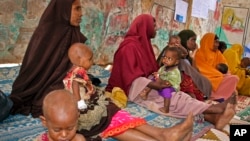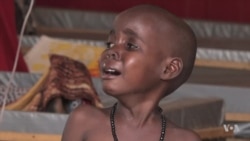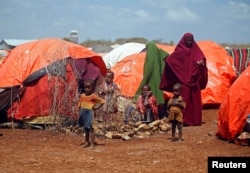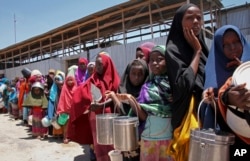A regional drought has displaced more than half a million people in Somalia and left the country at risk of famine. A cholera outbreak is further complicating relief efforts, in particular in the southern part of the country where some villages remain under al-Shabab control.
Somalia continues to report between 200 and 300 cases of cholera nationwide each day.
Bay Regional Hospital, the biggest in the southwest federal state, is filled with patients suffering from stomach pain, vomiting and diarrhea.
Cholera has sickened more than 40,000 people in Somalia since December. More than half of the cases have been in this state. Most of the victims have been malnourished children.
Five-year-old Fatuma was admitted to the cholera treatment ward last night. Her mother, Bisharo Mohammed, says she can not lose another child.
She says her eldest daughter was suffering from diarrhea, and she died two months ago in Busley village on the outskirts of Baidoa. She says the girl was seven years old.
Cholera treatment
Cholera is treatable. The World Health Organization recommends “prompt administration of oral rehydration salts.” Mohamed says Fatuma is already feeling better with treatment. They hope to be released soon.
But they will not be going home.
Aid agencies say the areas worst hit by cholera and hunger are villages like Busley, which are under al-Shabab control. Accessing them is a challenge. Fatuma and her family are among the tens of thousands of people who have walked to government-controlled areas like Baidoa to seek help and are now living in makeshift camps.
World Health Organization cholera expert Dr. Abdinasir Abubakar says the outbreak is getting worse due to security challenges.
“If you look at Bay, Bakool, Middle Juba, Gedo, some of those areas where none of us is able to access, the deaths and cases due to cholera [are] very high, and we expect the situation will get worse,” says Abubakar.
Rains this month in southern and central Somalia have contributed to a surge in cholera cases, according to Salima Sheikh Shuaib, cholera treatment ward deputy supervisor at Bay Regional Hospital.
She says “the cholera cases were going down, but the past three days we have seen an increase in cholera cases. This morning, we have received 16 cases and most of them are children under the age of five.”
Life in camps
More than 150,000 displaced people are living in the makeshift camps around Baidoa and more continue to arrive.
At the camps, many families do not have plastic tarps or covered places to sleep. Stagnant puddles and mud dot the walkways. There is no regular food provided. Clean water is available, but it is not enough.
Medics supported by UNICEF and the WHO are going to IDP camps around Baidoa to provide oral cholera vaccination to children.
But Abubakar of the WHO says it is hard to contain the spread of cholera so long as the general humanitarian situation is not improving.
“We cannot only solve cholera. We cannot only deal with cholera unless we deal with food insecurity, unless we deal with water issues, malnutrition and I think collectively, both the wash, the health, the nutrition, and the food security partners, we are working closely and we are coordinating but again in Somalia one of the challenges we are facing [is] a shortage of resources to support all these interventions,” said Abubakar.
Somalia continues to report between 200 and 300 cases of cholera nationwide each day.













